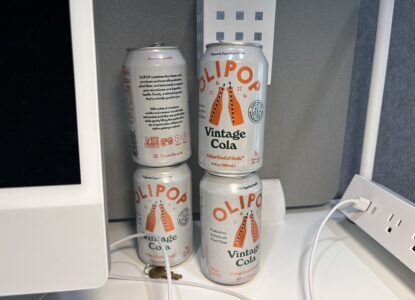My WHOOP Strap 4.0 Review: Why I Pay to Track HRV
Article at a Glance
- I use the Whoop Strap to “check in” with my current state of health and as a reminder that vices, like drinking and overdoing it with caffeine, have a real impact on my body that can ripple out days after a slip up.
- By far the most important thing Whoop has taught me is just how deleterious even two drinks are to my health and sleep.
- Whoop excels at tracking HRV, heart rate, and total sleep, and is less accurate with REM and deep sleep.
- Whoop hardware, with its straps and external batteries, can be awkward to use. The parts are easy to lose. They also represent an upsell opportunity that can meaningfully increase the cost of using the app.
- No matter which accessories you buy, WHOOP charges a $239 annual membership subscription.
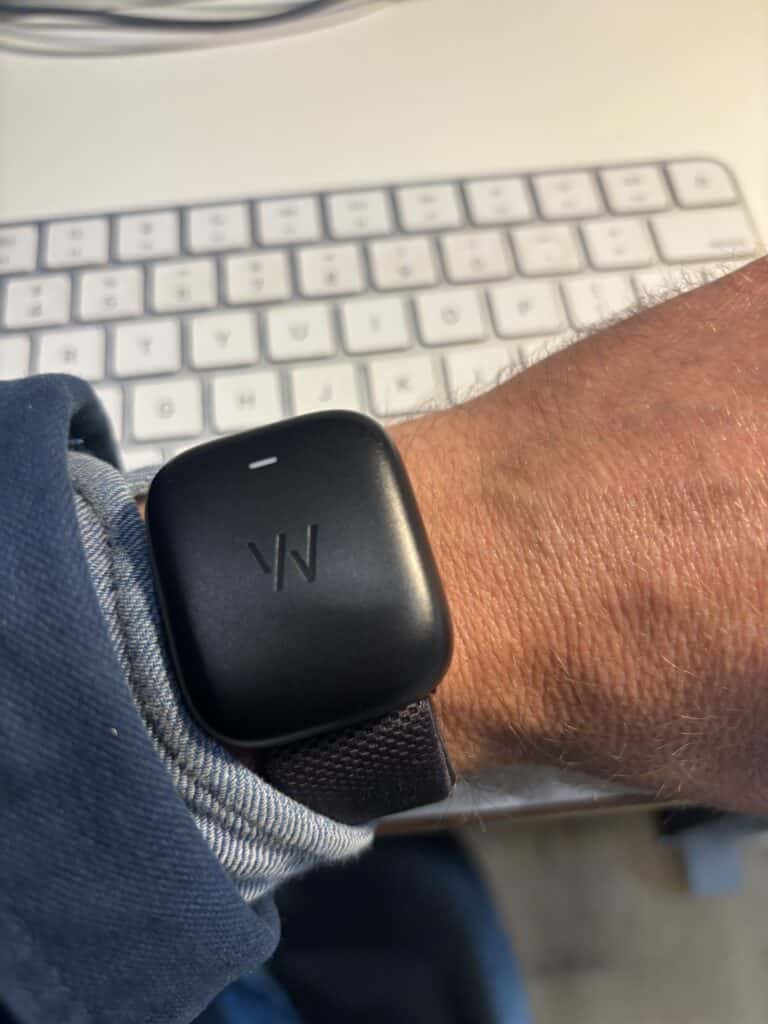
In this review, I want to talk about my experience using the new WHOOP 4.0 product and highlight both the pros and the cons, especially for our customers who just received their library of sleep reports and are looking to put them to use with some actionable data.
Essentially, this review is being written by an under slept Dad who uses Whoop not as a single “source of truth,” but as a barometer for my level of balance relative to previous periods in my life.
I used to think of myself as a “stressed out entrepreneur” when living in NYC, but those days were a beach vacation compared to wrangling a couple of toddlers.
Here’s the story.
My wife and I were blessed to have two little ones come into our lives 19 months apart starting in the fall of 2021. My kids are the joy of my life and I couldn’t imagine my life without them. But to say they have had an impact on my sleep would be an understatement. Our son in particular has been a real challenge and is only now sleeping all the way through the night at age two. Since we elected not to sleep train and have no nanny, the frequent wake ups began to impact my health. Wearing a Whoop is a way to remind myself to prioritize sleep and work in healthy habits aimed at restoring my baseline now that my son is finally making it through the night more often.
My North Star metric with Whoop is HRV. I care less about the sleep stages data, because as we will learn, these metrics from Whoop and Oura are still not ready for prime time.
What I paid:
I paid $239 for my WHOOP “membership which renews annually and $98 for a Basics Pack with extra battery and stylized strap. The standard issue black strap will be too utilitarian for many people.
Why I am wearing the Whoop
I have used both the Whoop Strap and Oura Ring on and off for many years now, and have documented my love hate relationship with these devices several times on the Gene Food blog. The “Nocebo” effect of consumer sleep tracking is very real. You might otherwise have woken up and had a great day despite poor sleep, but if your device tells you recovery was subpar it has a suggestive effect, which can create bad days. Sometimes it’s better not to know than to be waist deep in biomarkers every day.
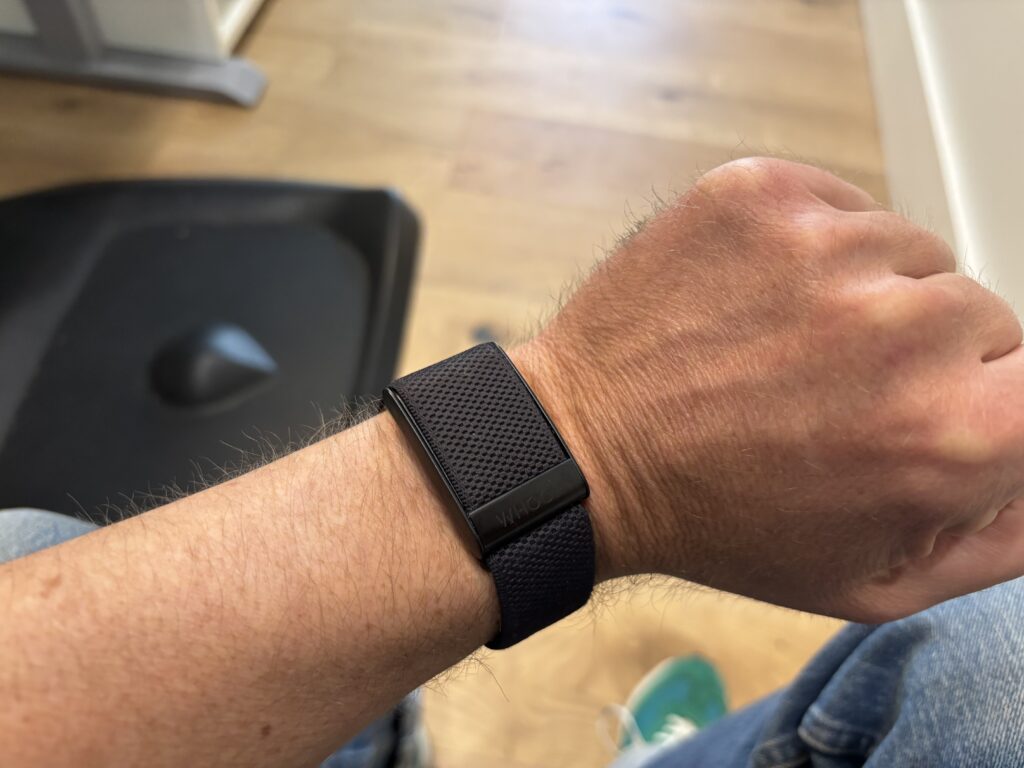
I’ve even worn an Oura Ring and Whoop Strap at the same time to see which performs best (you can read that post, here). While in my opinion Oura has the more elegant overall product, both with the charging process (which doesn’t require a separate battery pack) and a smaller piece of hardware, I gravitate back to the Whoop because I prefer a wristband to a ring, and I find the “digital bedside manner” a little better with the Whoop. I also like the delivery of the Whoop Recovery score better than the Oura Readiness score. That, and it’s always been my belief that the wrist location of Whoop triggers fewer false positive wake ups than does the Oura ring because our fingers move more than our wrists.
When I have worn both devices at the same time, I have consistently had the Whoop report more sleep than the Oura ring by about 30 minutes each night. Now to be fair, this could be a bug and not a feature. One study which compared Whoop to polysomnography (the gold standard for measuring sleep) found that Whoop tended to overestimate sleep (but not enough to discredit Whoop data).

Get Started With Personalized Nutrition
Gene Food uses a proprietary algorithm to divide people into one of twenty diet types based on genetics. We score for cholesterol and sterol hyperabsorption, MTHFR status, histamine clearance, carbohydrate tolerance, and more. Where do you fit?
What the Whoop does well
As I alluded to above, there are a handful of studies looking at the accuracy of various consumer sleep trackers, and although the data sets are small, we have a pretty good idea of what Whoop does well, and where it struggles. For example, this Central Queensland University study, which Whoop included in a PR campaign, found that Whoop is very good at detecting total sleep, heart rate, and heart rate variability (HRV), and less effective at determining a user’s actual sleep cycle.
The biggest reason I use Whoop is to track HRV, as well as resting heart rate. Why do I want to keep a close eye on HRV in particular?
This write-up in Current Cardiology Reviews says it better than I ever could:
Knowing about HRV is one of the best ways to assess the impact of various factors such as; environment, emotion, thoughts, feeling, etc., on the nervous system and how the nervous system responds accordingly.
Curr Cardiol Rev. 2021 Oct 22; 17(5): e160721189770.
In essence, HRV measures the body’s ability to relax.
Alcohol and HRV don’t mix
Knowing the HRV numbers are accurate is important because that is the metric I use to deter bad habits from creeping in, with alcohol being the big one. You could argue that the single biggest benefit of wearing a sleep tracker like Whoop is seeing how much of an impact drinking almost any amount of alcohol has on the body’s ability to recover. Put simply, drinking destroys my HRV number and those of us who are parents know that alcohol and little kids don’t mix anyway.
Although I have long argued that our current culture of the Quantified Self, where everything is measured, can create unhealthy neurosis, I also see value in cycling on and off with these devices as a motivator to stick to a lifestyle that builds wellness, and there is no better reminder of how bad booze is for me than the Whoop strap.
Other HRV insights
Interestingly, I have also found that despite my normal tissue transglutaminase labs being normal, wheat seems to have a negative effect on my HRV, as does drinking caffeine later in the evening. Waking up and being able to tie back a decrease in sleep performance to those two slices of pizza at 8 pm has a meaningful impact on my behavior. Further, it helps to reinforce what I already know about my genetic profile, that I carry some SNPs associated with sensitivity to eating wheat.
Because I need to sleep when the kids do, I am not following my sleep chronotype, which is owl, so that may have an impact on my overall sleep score as well.
In this sense, the accuracy of Whoop’s ability to gauge sleep cycles is secondary for me. The primary reason I wear the device sometimes is to check in on my level of stress and measure it against by previous baselines. In short, Whoop, especially when worn for years, is a good window into your current state of health, even if the deep sleep and REM data is imperfect.
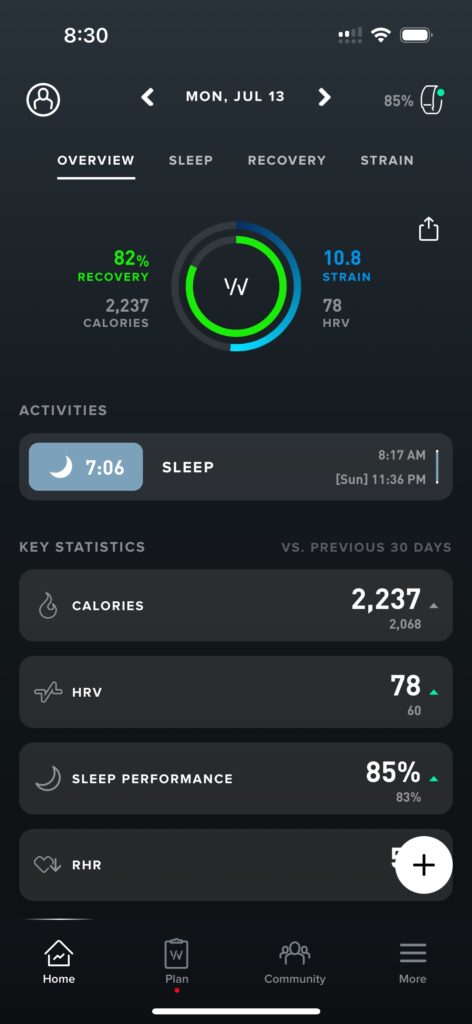
What could be improved
First, the setup is a bit clunky. With Whoop, you have to lug around external battery packs and wrist bands, and the cost to replace them (or order extras) really adds up. To charge the device, you first charge the battery and then clip the battery on top of the screen less Whoop wristband. It’s easy to do, but especially when traveling, it losing track of all the parts is a real issue.
Managing accessories
I spent $98 on a “Basics pack” which gave me an extra strap and battery which charges via a USB-C cable. The price for all the ancillary gear seems expensive especially because it’s not the best quality. When you factor in that Whoop is a “membership” which requires a subscription of $239 annually, the current price point will put the service out of reach for many.
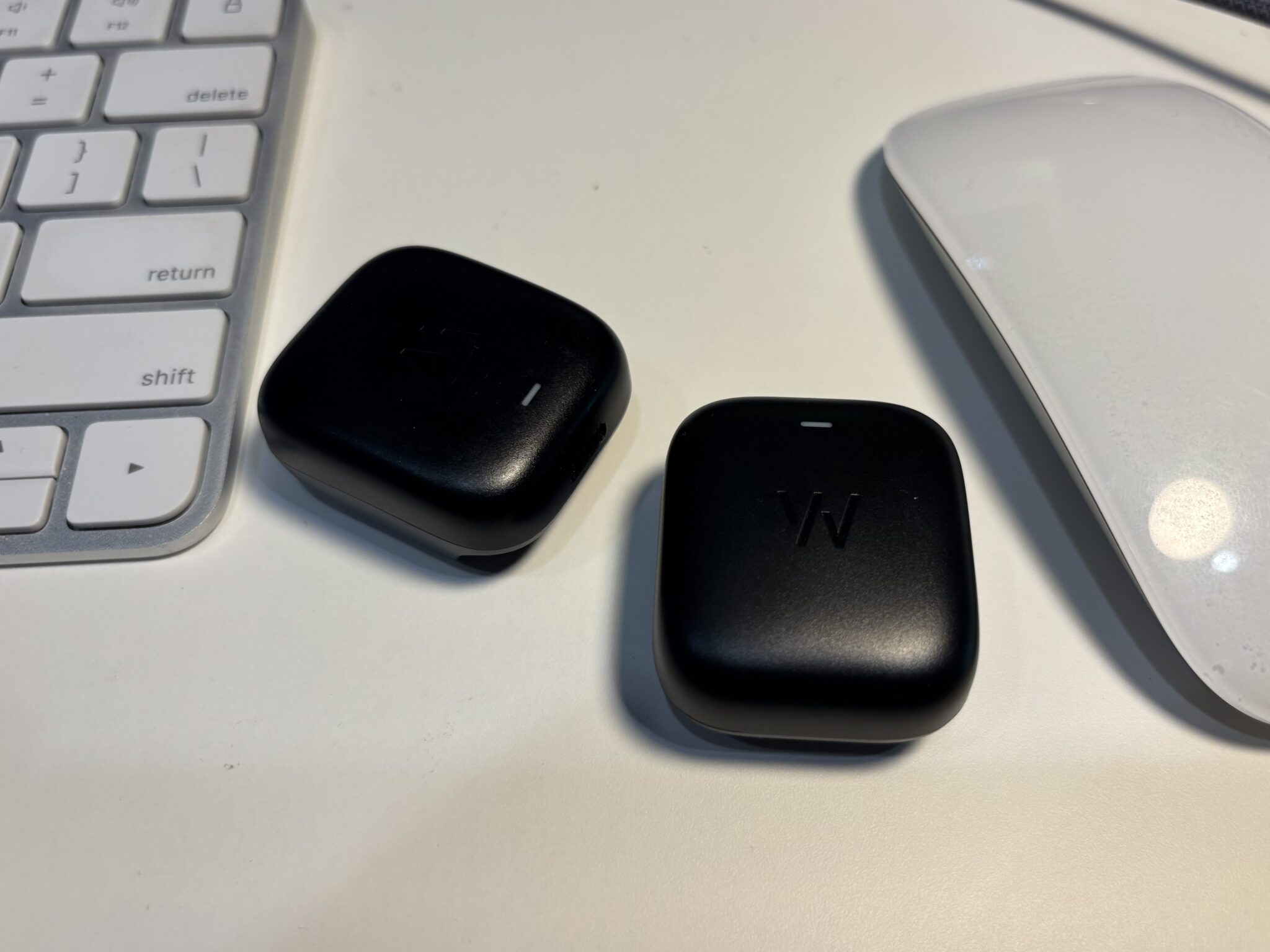
The sweat and shower issue
I am going to come out and say it – I hate the band. It’s awkward to change, adds cost, and it gets wet all the time.
Whoop is designed for athletes, so by definition, you are sweating when wearing the band. In light of the fact that most users will have only a handful of straps at any given time, this has always seemed like a major weakness to me. There are several Reddit threads discussing this issue, with some commenters saying they wear the Whoop in the shower and soap it up there. I have never been a fan of wearing my Whoop in the shower as it means I will also have to let it dry for about an hour.
Consider this Reddit quote from FactCheckExpert (who agrees with me):
I think the biggest point and flaw with whoop is the fact it gets wet at all from sweat or swimming, and needs to be dry. I mean the thing is goddang marketed at the working out crowd. It should be dry, instantly dry, from a towel, just like the Fitbit or any other tracker. I was literally about to buy the damn thing but then thought about this and got very irritated by it.
This is where Oura has Whoop beaten, their hardware is simpler and much easier to deal with after a workout. The ring has nothing to absorb sweat whereas the Whoop band gets wet.
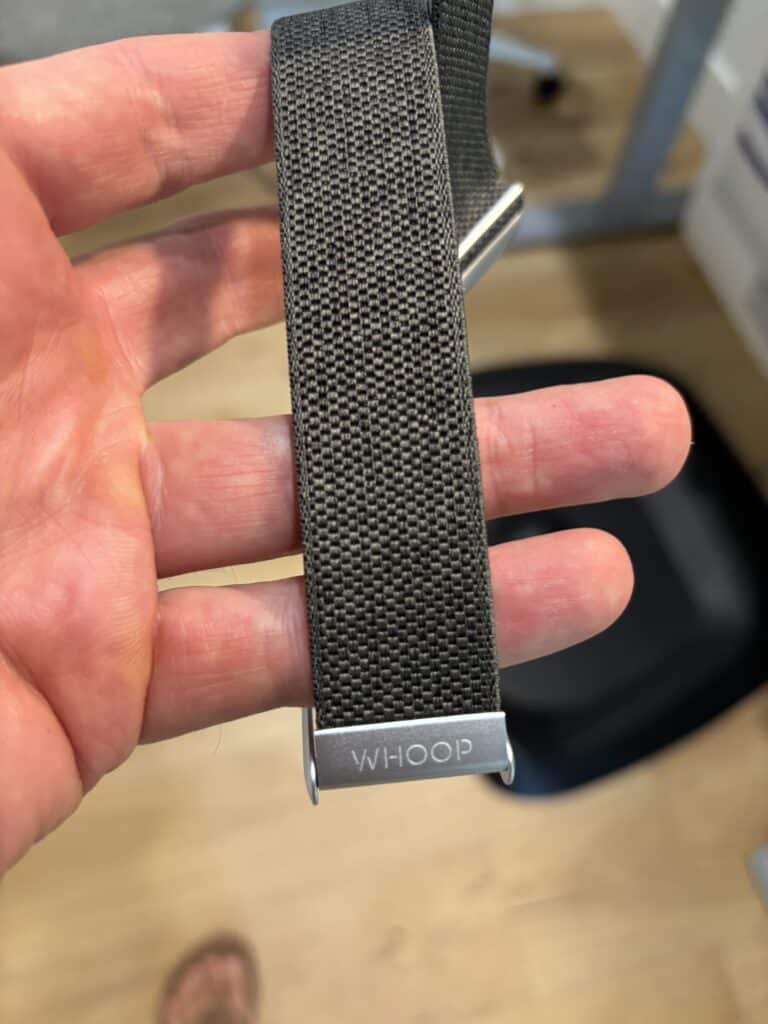
Slow load times and data catch up
Another area I would love to see Whoop improve is load speed. There always seems to be a long lag time between when I open the app and when results are ready. Sometimes it can take several minutes for the app to register my sleep and display results. This data catch up period will be frustrating for some users.
The bottom line
The bottom line for me is that, even if the REM and deep sleep data isn’t perfect, I get value from wearing a Whoop intermittently. The immediate morning feedback offers accountability.
Knowing I have my Whoop to “answer to” in the morning helps to reinforce healthy habits, prioritize sleep, and probably makes me a better parent.

Get Started With Personalized Nutrition
Gene Food uses a proprietary algorithm to divide people into one of twenty diet types based on genetics. We score for cholesterol and sterol hyperabsorption, MTHFR status, histamine clearance, carbohydrate tolerance, and more. Where do you fit?


